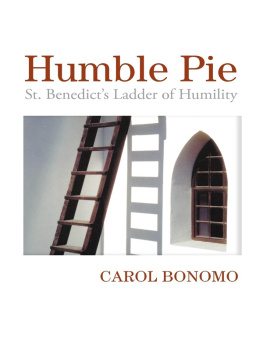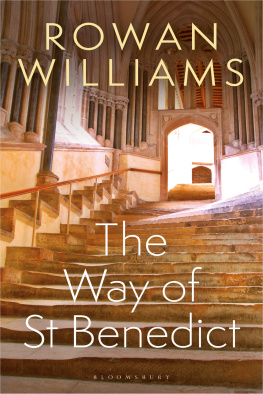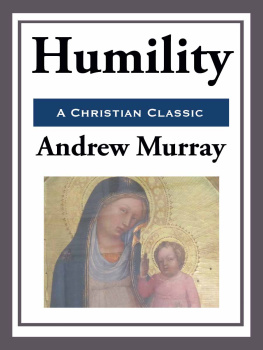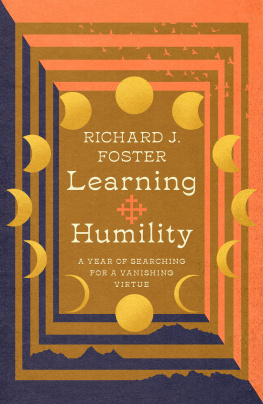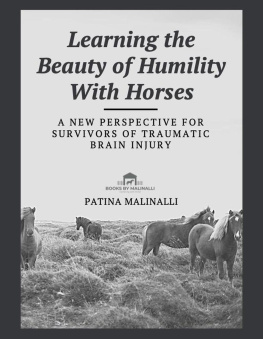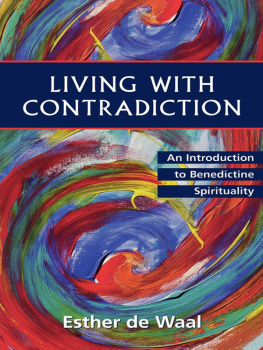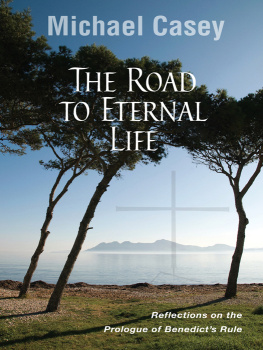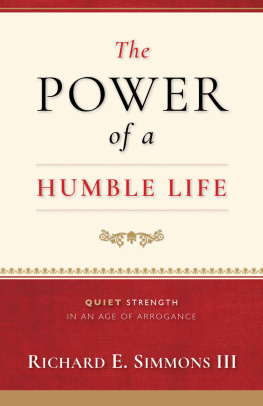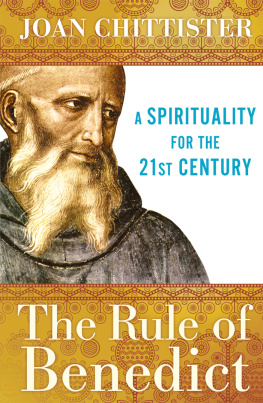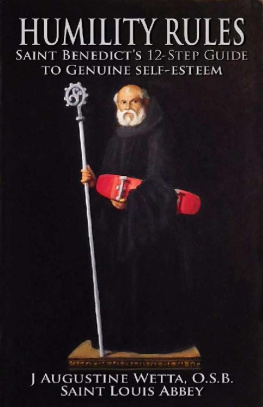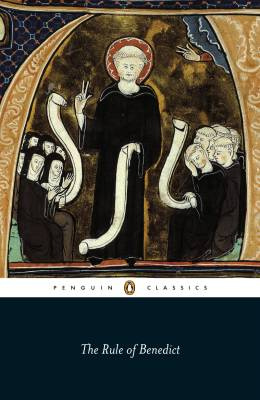Copyright 2003 by Carol Bonomo
All rights reserved. No part of this book may be reproduced, stored in a retrieval system, or transmitted in any form or by any means, electronic or mechanical, including photocopying, recording, or otherwise, without the written permission of the publisher.
Morehouse Publishing, 4775 Linglestown Road, Harrisburg, PA 17112
Morehouse Publishing, 445 Fifth Avenue, New York, NY 10016
Morehouse Publishing is an imprint of Church Publishing Incorporated. www.churchpublishing.org
Library of Congress Cataloging-in-Publication Data
Bonomo, Carol, 1952
Humble pie : St. Benedict's ladder of humility / by Carol Bonomo.
p. cm
Includes bibliographical references.
ISBN 978-0-8192-1960-2
1. Benedict, Saint, Abbot of Monte Cassino. De humilitate. 2. HumilityChristianityHistory of doctrines. I. Title.
BX3004.Z5B66 2004
241'.4dc21 2003012404
Printed in the United States of America
For Felix
who stopped to consider the lilies of the field
but decided he liked roses better.

The LORD is our savior;
we shall sing to stringed instruments
In the house of the LORD
all the days of our life.
Isaiah 38:20
Acknowledgments
The best thing about acknowledgments is that they force you to remember that you never accomplish anything meaningful alone. St. Benedict would approve of this insight and wonder what took me so long.
At Morehouse Publishing, Debra Farrington and later Nancy Fitzgerald provided enthusiasm, clarity, and insight to my initial flourishes on humility, as well as good humor to my morning e-mails.
My long-distance volunteer researchers were my mother, Barbara, in Rhode Island, and Blanche Monacco, my sister-in-law, in Arizona. Arlene Ruiz, my coworker and prayer partner, was a living biblical concordancebetter, faster, and much nicer than any on-line Bible for finding specific references that I could only remember in generalities. My colleague and stringed instrument guru, Richard Riehl, was a thorough reader of the draft manuscript, as well as my backup music coach.
I am blessed with extraordinary teachers. The old abbot pulled me into Benedict's fold graciously but firmly. Auntie Margie of Kamuela, Hawaii, taught me more than she can possibly imagine.
Special acknowledgment to my best friend and life companion, my husband Felix. And I always need to acknowledge my patron, Blessed Joanna Mary, who must have been praying overtime on this one.
Carol Joanna Mary Bonomo
Prelude
The Preparation
Advent
I thought humility would be fun. Maybe it wouldn't be holding-my-sides-laughing fun, but fun, as in different and daring and darling to look at. It's not exactly like I'm an expert on humilitynor could I admit it if I were.
Humility is that kind of funthe weird, backwards kind that had Alice in Wonderland questioning her luncheon mushroom.
With a subject like humility, you've got to start somewhere, and Advent is as good a starting place as any. Advent is the beginning of the Church's liturgical year, the time of preparation before Christmas takes over. I need a little time of preparation before jumping headfirst into humility.
Humility is terribly important to understand if you're a Benedictine monk or even a lay Benedictine oblate. St. Benedict must have cared deeply about humility. It is by far the longest chapter in the little Rule he wrote, and he gives us twelve steps to achieving humility. If he cared, I care. If he thought humility was that important in the sixth century when he wrote his Rule, then maybe it's still important in this century as well.
Until I became a Benedictine oblate, the only steps I'd ever heard of came from all those Twelve-Step programs: Alcoholics Anonymous and its dozens of anonymous spin-offs, from nicotine to overeaters to sex to shopping. I think that's where the idea of looking at Benedict's steps of humility as some sort of fun originated. I thought it must be an ancient self-help modelHumility Anonymouswhere you got up and bragged about your humility until everybody yelled at you to sit down.
Well, it sounded fun at first. But there was trouble right off the bat. For one thing, the twelve steps bored mebeen there, done that, in AA for four or five years until I ran away looking for something more fun and stumbled into the Catholic Church. For another, the self-help twelve steps and Benedict's twelve have nothing in common other than their twelveness. Who knew?
Some things take a while to figure out. Apparently, humility is one of those things, even though St. Benedict breaks it out into twelve steps. But I'm a slow learner. I was an oblate for a couple of years before I began to grasp the Benedictine charismaits marketing brand, its distinction, what makes it Benedictine instead of, say, Franciscan. Abbot Antony, our oblate master at the monastery, told me early on, Our life is the liturgythe Divine Office, or Liturgy of the Hours that the Church has prayed since the earliest times. That should have been a clue.
Reading the Rule should have been another clue about what makes Benedictines Benedictine. Humility is the longest chapter, but the biggest number of chapters in the Rule dictates the prayers of the liturgy. Humility may lie at the heart of a Benedictine life, but the liturgy of hours, weeks, and years wraps around that life like a well-worn habit.
Maybe it's less fun to structure a look at humility, but at least it's tidy, and I like tidy nearly as much as fun. This Advent I am preparing to look at the humble heart of Benedictine life and wrap it in the cloak of the memories and liturgical practices of my life in the world. I have a perfectly good reason for this plan: I know absolutely nothing about humility in any form or under any conditions. Jamie, my coworker at the university, is in the same boat. In college, she was theatre and I was opera, and our long-ago choices of college majors, overwritten many times, probably suit our dispositions as well. Old performers never die; they just keep reaching for that applause button like a rat in a cage pushing a lever for food pellets. These days I'm a lobbyist and Jamie's a fund-raiser, and we are both late bloomers enjoying the afternoon sun on our careers.
Jamie tells me, So I looked around and said to myself, Should I walk into the room and take it over because it's fun and I can do it, or should I grow up and try to take myself seriously?
We look at each other, full of the thrill and power old performers know of what it's like to walk into a room full of people more important and powerful than we'll ever be, and know that within minutes we'll be the only person there who matters. Who wants to grow up anyway?
Nah, we both say. Showmanship over sincerity every time. Anything over humility anytime. Humility's steps are perfect for me: haven't been there, haven't done that.
And with that decision, I just need to find wallpaper, which is what I call the place where I study and the people in that place. I'm sure it's not respectful to think of a monastery or church or retreat houseand the good people who work there and make me feel welcome thereas wallpaper, but that's what I do. I need a place of interactions for humility, and not just any old place.
I want to find once again the wallpaper I knew too late as a kid. Growing up Episcopalian in Rhode Island, I went to church camp one summer in Pascoag, a wooded retreat with cabins, crafts, daily chapel, and evening prayer, plus a lake for brisk daily swims.

